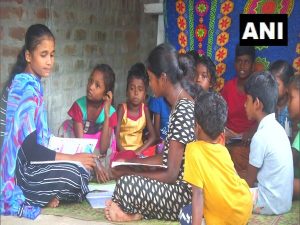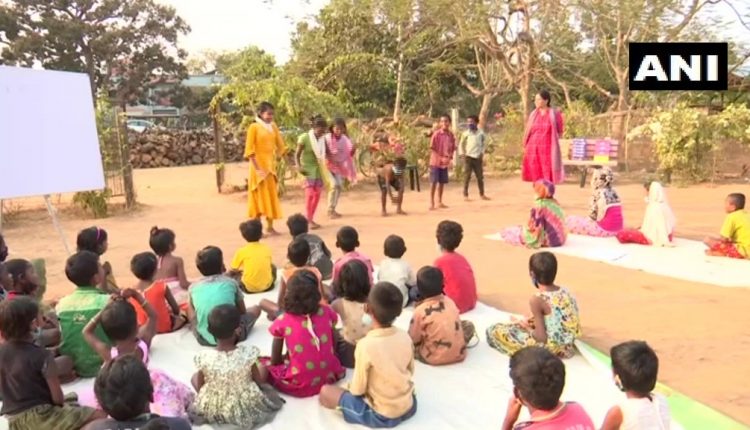Rebooting School System — A Challenging Task Ahead
Bhubaneswar: In early February, many state governments and Union Territories reopened schools in a phased manner, with satisfactory circumstances being met of low COVID-19 positivity rate, decreasing trends of active cases, immunisation protection among adults and low risk of fatalities for children with Omicron variant.
In Odisha, the Department of Mass Education has issued strict guidelines for operating schools in offline mode with limit on class size, sanitisation of campus and fixing infrastructures like washrooms and handwashing areas. Strict adherence to such norms is enforced by district and local administration. Although resuming offline classes marks an important step towards pre-COVID normalcy, in many ways this ‘re-entry’ has become a challenging task for school administration, parents and students.
Sandhya, a 13-year-old girl from Bhubaneshwar, enjoyed the online education for a few months but shortly projected some physiological and psychological changes like change in appetite and sleep patterns, anxiety, anger, mood swings. Even before the pandemic, at least 50 million children were affected with mental health issues although only 10 per cent to 15 per cent are identified and treated for.
Notably, these increased mental health disorders are a trend across the country during the pandemic. In a UNICEF survey conducted during the first half of 2021, 14 per cent of respondents between the age of 15 to 24 in India reported being depressed or showed a lack of interest in day-to-day work.
This points towards the crucial role of school education and peer-to-peer networking among children during this age. The schools are more than a place for education in India, they are public institutions where every child is ensured of healthy, nutritious food under schemes like Mid-Day meal; provided school materials like books and uniforms; guaranteed primary education securing their childhood and wholesome development within their social fabric.
More than 80 per cent of students are part of the government school ecosystem; this number is higher than 90 per cent in rural Odisha. In the absent routine of school, there have been instances of higher dropout rates, increased child labour, child marriage and increased cases of violence against children in the state.

Loss of Learning and more
According to the Asian Development Bank projection, children in South Asian countries, including India, could lose up to 4.7 per cent of their future earnings due to school closures of about 600-plus days.
Although the state government had quickly switched to digital schooling, almost 35 per cent of the students were automatically filtered out of the education system due to the unavailability of smartphones.
In the case of Sandhya, her parents, seeing her behaviour changes took time to engage her in activities and spend more time with her.
While talking about her situation she said, “I can’t help what is happening externally. I am trying my best to cope.” Although Sandhya still missed the peer-to-peer interactions with her friends, especially when two of her friends didn’t have access to mobile phones hence no online classes.
Even with smartphones and government programmes in place, many students lacked the required support from their family members to deal with their emotional, social and learning requirements during the pandemic. The devastating effects could be felt at present as the progress of learning has been affected. In subjects such as mathematics, science and communication, there is notably a poor performance registered.
Severe depression, anxiety and other mental health diseases have also been rising among school students. Especially the children of economically devastated households have been reallocated to working in shops and farms.
Challenging Welcome
Since the news of school reopening, Sandhya, like many children, has been excited so are the parents. But just like the first one, this transition also comes with its challenges.
In many cases, the eagerness of parents is unmatched by the children who are awaiting their final exams one month before their summer vacation. The teachers and students are disengaged and having difficulties contemplating the end of the year.
Affected by this, many students especially in advanced classes are having stress and anxiety issues, for whom the board examination results are crucial for their academic career. For young students and their parents, the transition has become disbalancing and difficult to adapt to on short notice.
While schools are to undertake additional measures to build capabilities for a clean and hygienic place for students by instilling healthy habits and behaviour guidelines, vaccination for children under 15 years is yet under consideration. The reluctance of private schools to reopen is voiced with the demands of parents to continue online mode for the year. Although, many states and UTs have proposed ‘Hybrid mode’ for the remaining year to accommodate limitations of school infrastructure as well as concerns of parents.
Re-entry vitalisation
However, the critical concerns of the education system are at large masked under the re-adjustment period. In Odisha devastation by COVID-19 and cyclones has destroyed the livelihood and forced many families to migrate. The state government would have to reprogram counselling sessions with families and communities of children who dropped out in adverse financial situations.
The regressive social traditions have forced girls to finish household chores over classes are bound to eliminate their chances of returning to school. The most vulnerable in terms of loss of cognitive and physical development are the children from rural and tribal areas, in dire need of targeted interventions to bridge the learning gap before the next term in June.
Arranging special classes by the government, associated organisations and NGOs need to formulate a short-term course curriculum to help with mathematics, writing and speaking skills, language tuition and physical education over the course of summer break. With the help of families, communities and school administration, the children lost to work need to be brought back to finish their remaining education in special classes arranged at a convenient time during evenings. Additionally, the students necessitating joining the workforce could be provided with vocational, technical, computer and entrepreneurial skills to improve their prospects of better employment.
Education of 24.7 crore children in elementary and secondary school and 2.8 crore children in preschool has been affected in India, according to UNICEF.
In many households, due to tragic circumstances and social responsibilities handed to young children snatched their childhood from them. It has permanently changed the school-student relations and impacted the understanding of education for many young children. Now, the government has the towering task of putting the displaced students on the right path and encouraging the parents and families to support the children through this transition.
(The writer is MLA of the Bhandaripokhari constituency, Odisha. The views in this article are that of the author and do not represent the opinion of educationbytes.in)


Comments are closed.